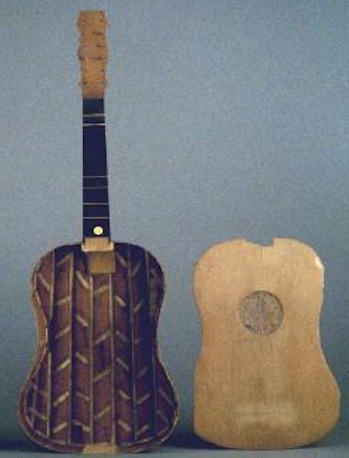Vihuela, 16th century, Paris, Musée de la Musique.
Paris: Musée de la Musique.
instrument: vihuela de mano | century: 16cent/3/late | catalogue nº: 16-304

Artwork
Creator
Medium Instrument
Location
City Paris | Region France | Old kingdom
Characteristics
| Body Waisted | Strings 6 courses | Neck Long | Pegbox Angled flat |
| Bridge Fixed | Frets Yes | Back Vaulted | Pegs Rear |
| Technique None |
Commentary
INSTRUMENT
Vihuela, later 16th century. Maker, place and date unknown. Paris, Musée de la Musique, (E.0748). The instrument has no indication of its provenance.
Description: Vaulted back of 7 fluted ribs. It has quite a wide body for its length. Soundboard: fir / Back and sides: mahogany?? / Neck - probably cypress / Soundboard has a parchment rose, and 2 internal bars immediately above and below the soundhole. Soundboard thickness is 1.6 - 3.6 mm. The thickest areas are in the centre, and the thinnest at the edges. Bridge has slots at the bottom for six courses. Pegbox is angled, with what appears to be a v-joint, but it is actually one piece with the neck. Body is slightly asymmetrical - possibly not made in a mould [?]. Principal dimensions: Overall length = 900 mm; Body length = 435; upper bout = 275; Waist = 327; lower bout = 327; string length = +/- 640; Pegbox = 175; Neck width at nut = 44; at body join = 58; Neck length from body join to nut = 290.
History: The instrument belonged to the collection of Genevieve Thibault de Chambure, former curator of the museum. She appears to have acquired the instrument in the 1960s, and the instrument has been in the Musée de la Musique since July 1971. The Museum conservas a handwritten letter to Thibault dated 13.Oct.1966 from Michael Prynne, obviously a response to a request from her for help with identification of the instrument. The letter has 3 B/W photographs of the instrument at that time. At that time the instrument was intact, and possibly in playable condition. Prynne did not judge it as a vihuela because of its vaulted back, rather an inferior guitar of the 17th century, and probably Italian or German.
Conservation. At some point between 1966 and 1998, the soundboard and brdge became removed from the instrument, possibly as the result of trying to string it. All the parts have been conserved, and there has been no attempt to restore the instrument. Photos at http://servsim.cite-musique.fr/museedelamusique/photo.asp
Rosette: Alexander Batov informs (e-mail to John Griffiths 29 March 2004): “In fact, the rose on the anonymous vihuela E0748 in the Cite de la Musique is a classical example of 16th century Venetian rose a numerous examples of which can be found in harpsichords and surviving early 17th century guitars (those from the Sellas family workshop which was based in Venice in particularly). One of the two roses that I currently use on my fluted-back vihuelas is based on the same design as the one in E0748 and I copied it from a 16th century Italian harpsichord in the KHM, Nurnberg (see link to my web page for details). The entry in the "Inventario del contenido del taller del violero toledano, Mateo de Arratia" of 1575 lists "Ochenta y ocho tapas de las de venicia con sus lazos a tres reales..." (p.482 of the above mentioned book by Jose Romanillos). So it may also be that the sunk three dimensional parchment roses were also shipped from Venice. I saw no mentioning so far in original sources (the ones I came across with) that Spanish violeros were supposed to make parchment roses themselves but only to carve them from ebony or boxwood (as it does appear in, say, Toledo ordinances, 1617) and I am still trying to find an adequate explanation to what in original sources is referred to as “lazo hondo” and “lazo en la tapa”.
Another site: http://collectionsdumusee.philharmoniedeparis.fr/0159084-vihuela-de-mano.aspx
http://www.mimo-international.com/MIMO/doc/IFD/OAI_CIMU_ALOES_0159084